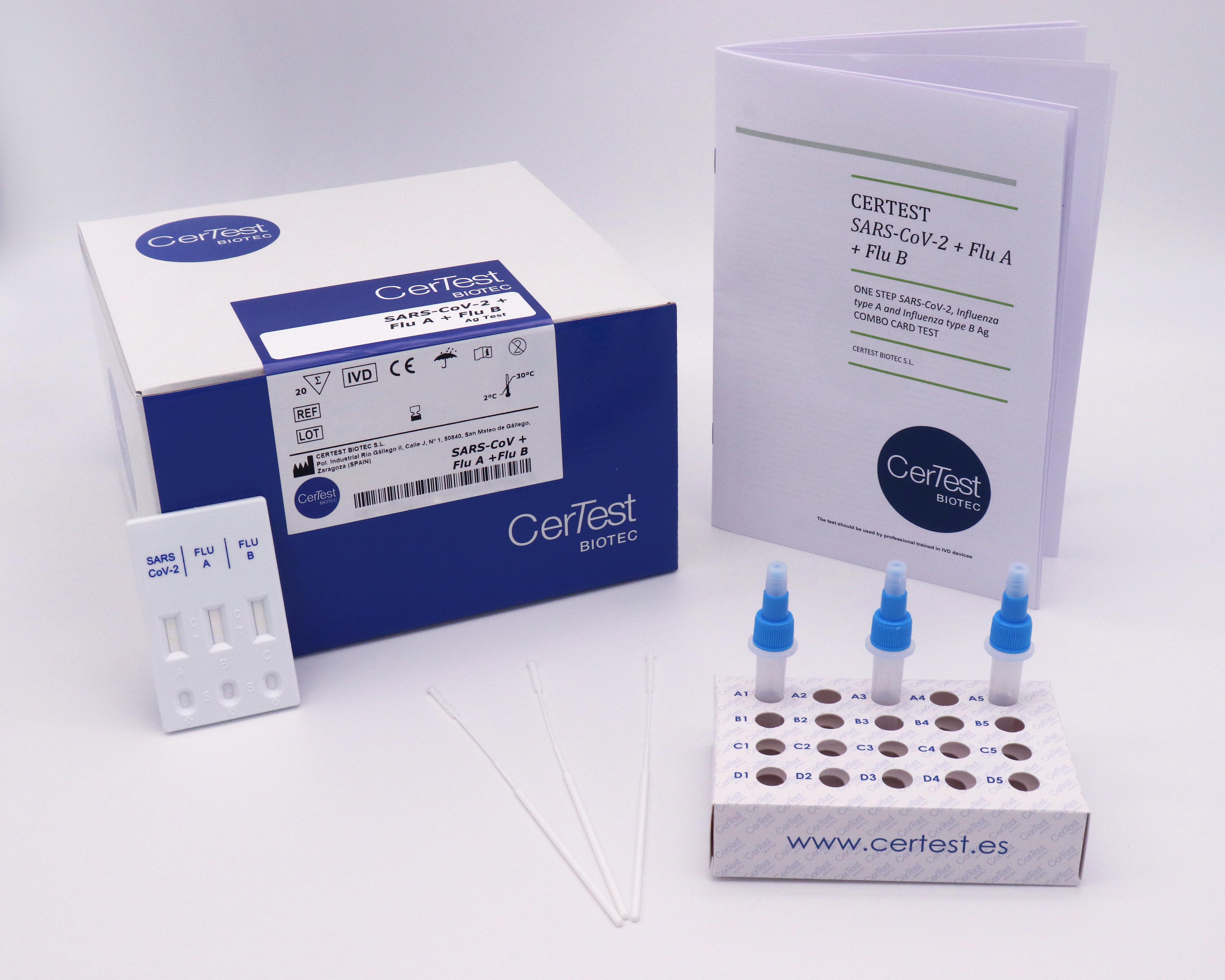
Rapid Test
SARS-CoV-2 + Flu A + Flu B

Description
CerTest SARS-CoV-2 + Flu A + Flu B one step combo card test is a coloured chromatographic immunoassay for the simultaneous qualitative detection of nucleoprotein antigen of SARS-CoV-2, Influenza type A and Influenza type B from nasopharyngeal swab samples from patients suspected of COVID-19 infection and/or Influenza A and/or Influenza B infection.
CerTest SARS-CoV-2 + Flu A + Flu B combo card test offers a simple and highly sensitive screening assay as aid in the diagnosis of SARS-CoV-2 and/or Influenza type A and/or Influenza type B infection.
Specifications
Information
An unseen pneumonia spread swiftly in Wuhan, China, in December 2019. Scientists sequenced and recognized a novel β-coronavirus.
The disease, caused by the Severe Acute Respiratory Syndrome Corona Virus 2 (SARS-CoV-2), is called as Coronavirus disease 2019 (COVID-19).
Coronaviruses (CoVs) are RNA, enveloped viruses, with a large genome (29.9 kb), amongst which β-CoVs and α-CoVs can infect mammals. Viruses belonging to the Coronaviridae family have the most abundant membrane protein (M) among other proteins, i.e. spike glycoprotein (S), nucleocapsid protein (N) and an envelope protein (E). Spike glycoprotein (S) is one of the targets of T cell response in the immune system. The S protein also promotes the binding of the virus envelope to the ACE2 receptor and the entry of the virus into the cell target. ACE2 receptors are present in cells of the arteries, veins, smooth muscles, small intestine, alveoli of the lungs, hair follicles, cardiac myofibroblasts, skin, brain, and kidney, thus SARS-CoV-2 could potentially infect these tissues.
Clinical forms of this disease comprise from mild to very severe symptoms: pneumonia, fever and respiratory symptoms are the most frequents. Other symptoms of the viral infection include a sore throat, aches, pains, and shortness of breath. In some cases, runny nose, nausea, and diarrhea also occur.
The outbreak of newly discovered coronavirus begins mainly via discharge from the nose or droplets of saliva, once an infected individual sneezes or coughs, and the estimated time for incubation is within 2 weeks. Due to the high infectious rate of SARS-CoV-2, detection of asymptomatic positive patients is probably one of the key points to controlling the outbreak.
Influenza is caused by a virus that attacks mainly the upper respiratory tract – the nose, throat and bronchi and rarely also the lungs. The infection usually lasts for about a week. It is characterized by sudden onset of high fever, myalgia, headache and severe malaise, non-productive cough, sore throat, and rhinitis. Most people recover within one to two weeks without requiring any medical treatment. In the very young, the elderly and people suffering from medical conditions such as lung diseases, diabetes, cancer, kidney or heart problems, Influenza poses a serious risk. In these people, the infection may lead to severe complications of underlying diseases, pneumonia and death.
The currently circulating influenza viruses that cause human disease are divided into two groups: A and B. Influenza A has 3 subtypes which are important for humans: A (H3N2), A (H1N1) and A (H5N1), of which the former is currently associated with most deaths. Influenza viruses are defined by 2 different protein components, known as antigens, on the surface of the virus. They are spike-like features called haemagglutinin (H) and neuraminidase (N) components.
